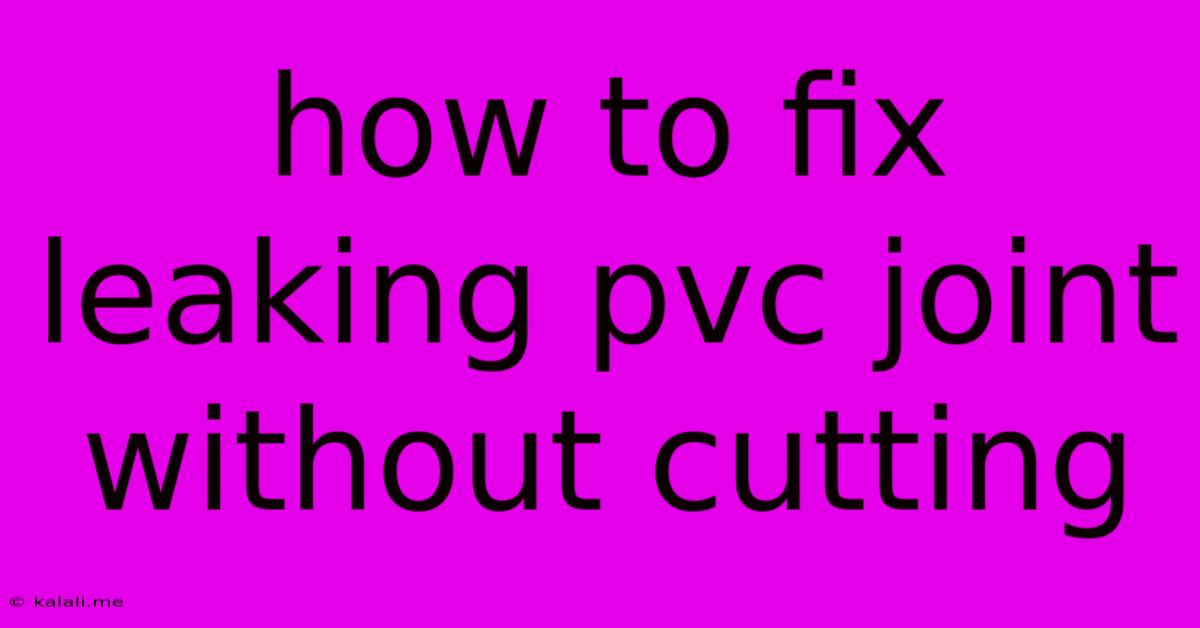How To Fix Leaking Pvc Joint Without Cutting
Kalali
May 23, 2025 · 4 min read

Table of Contents
How to Fix a Leaking PVC Joint Without Cutting: A Comprehensive Guide
Meta Description: Discover effective methods to repair a leaking PVC joint without the hassle of cutting. This guide explores various techniques, from using PVC pipe cement to applying specialized sealants, ensuring a lasting and watertight fix.
Leaking PVC joints are a common plumbing problem, often leading to water damage and costly repairs. The traditional solution involves cutting out the damaged section and replacing it, a process that can be time-consuming and require specialized tools. However, there are several effective ways to fix a leaking PVC joint without resorting to cutting, saving you time, effort, and money. This guide explores these methods, providing detailed instructions and considerations for each approach.
Assessing the Leak: The First Step
Before attempting any repair, carefully inspect the leaking joint. Identify the source of the leak—is it a small weep, a steady drip, or a significant flow? The severity of the leak will influence the best repair method. Also, check the surrounding area for signs of cracks or damage to the pipe itself, beyond the joint. This initial assessment is crucial for choosing the most appropriate and effective solution.
Method 1: Tightening the Joint (For Minor Leaks)
Sometimes, a seemingly leaking joint simply needs tightening. If the leak is minor and you suspect a loose connection, carefully attempt to tighten the joint using pipe wrenches. Caution: Excessive force can damage the PVC pipe, so proceed with care and gradually increase pressure. If the leak persists after tightening, move to other methods.
Method 2: Applying PVC Pipe Cement (For Small Leaks)
For small leaks emanating from the joint itself (not the pipe), applying additional PVC cement might seal the gap. Important: This method only works if the leak is superficial and the original cement bond isn't completely compromised. Clean the joint thoroughly with a solvent designed for PVC, ensuring the area is dry and free from debris. Then, carefully apply a thin layer of fresh PVC cement to the joint, ensuring it penetrates the existing gap. Allow ample drying time as specified by the manufacturer's instructions.
Method 3: Utilizing PVC Pipe Sealant Tape (For Minor Leaks)
PVC sealant tape provides a quick and easy solution for minor leaks. Wrap the tape tightly around the leaking joint, ensuring complete coverage of the affected area. Choose a high-quality, waterproof tape specifically designed for PVC pipes. Overlapping layers can enhance the seal's effectiveness. This method is best suited for small leaks and may not be as durable as other solutions for more significant problems.
Method 4: Employing a Specialized Pipe Repair Clamp (For Medium Leaks)
For medium-sized leaks that don't respond to simpler solutions, a pipe repair clamp is an excellent option. These clamps are designed to encircle the leaking joint, providing a secure and watertight seal. Select a clamp specifically sized for your pipe diameter. Follow the manufacturer's instructions for proper installation, ensuring a tight and even compression around the joint. This offers a robust and durable repair, often lasting for an extended period.
Method 5: Using Epoxy Putty or Sealant (For Moderate to Severe Leaks)
Epoxy putty or a specialized pipe sealant offers a more permanent solution for moderate to severe leaks. Clean the area thoroughly, then carefully apply the putty or sealant, ensuring complete coverage of the leak. Allow sufficient curing time as recommended by the product instructions. This method provides a strong bond, making it suitable even for significant leaks. However, this requires careful application to ensure a proper seal.
When to Call a Professional
While these methods can effectively address many leaking PVC joints, some situations demand professional intervention. If the leak is severe, you suspect a larger problem within the plumbing system, or you're uncomfortable performing these repairs yourself, call a qualified plumber. Attempting complex repairs without the necessary expertise can lead to further damage and increased costs.
This guide offers a range of solutions for fixing a leaking PVC joint without the need for cutting. Remember to always prioritize safety, use appropriate protective gear, and choose the method best suited to the severity and nature of the leak. By following these steps, you can successfully repair your leaking PVC joint and avoid costly professional repairs.
Latest Posts
Latest Posts
-
How To Wire Two Lights To A Single Switch
May 23, 2025
-
3 0 Copper Wire For 200 Amp Service
May 23, 2025
-
What Is A Complete Solution Math
May 23, 2025
-
How To Find The Mean For Coin Toss
May 23, 2025
-
What Is The Color Of Mountain
May 23, 2025
Related Post
Thank you for visiting our website which covers about How To Fix Leaking Pvc Joint Without Cutting . We hope the information provided has been useful to you. Feel free to contact us if you have any questions or need further assistance. See you next time and don't miss to bookmark.